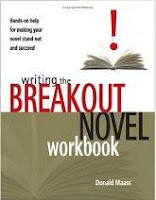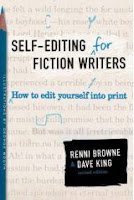Writing Tips & Tools
Tuesday, November 08, 2011
by Bonnie Calhoun
 Today we are continuing editing lessons from the book Self-Editing for Fiction Writers by Renni Browne and Dave King.
Today we are continuing editing lessons from the book Self-Editing for Fiction Writers by Renni Browne and Dave King.
These lessons will be shortened overviews of the chapters and by no means should be a substitute for buying the book. I'm rereading but not posting a lot of good stuff!
Let's continue. We've been working on Dialogue Mechanics.
Here are some dialogue faux pas...
"I hate to admit that," he grimaced.
"Come closer," she smiled.
"So you've changed your mind," he chuckled.
To use verbs like these three for speaker attributions is to brand yourself as an amateur...And to stick your character with an action that is physically impossible. No one outside of hack fiction has ever been able to grimace or smile or chuckle a sentence!
We're all in favor of choosing exactly the right verb for the action, but when you're writing speaker attributions the right verb is nearly always said.
The reason those well-intentioned attempts at variety don't work is that verbs other than said tend to draw attention away from the dialogue.
There are other ways to keep your speaker attributions transparent. Don't open a paragraph of dialogue with the speaker attribution. Instead, start a paragraph with dialogue and place the speaker attribution at the first natural break in the first sentence. ("I disagree," he said. "Plungers have...)
Place the character's name or pronoun first in a speaker attribution ("Dave said"). Reversing the two ("said Dave"), though often done, is less professional. It has a slightly old-fashioned, first-grade-reader flavor ("Run spot, run" said Jane.)
After all, "said he" fell out of favor sometime during the Taft administration...LOL!
CHECKLIST:
First check your dialogue for explanations. It may help to take a highlighter and mark every place where an emotion is mentioned outside of dialogue.
Cut the explanations and see how the dialogue reads without them. Better? Worse? If it's worse, then start rewriting your dialogue.
As long as you have your highlighter out, mark every -ly adverb. How many are there? How many of them are based on an adjective describing an emotion? You can probably do without most of them.
How about your speaker attributions? Any physical impossibilities? Any verbs other than said? Remember though, there are occasional exceptions, even innocuous verbs like replied or answered lack the unobtrusiveness of said.
Can you get rid of some of your speaker attributions entirely? Just drop them and see if it's still clear who is speaking.
Have you started a paragraph with a speaker attribution?
Name before noun ("Renni said") rather than the other way around ("said Renni")?
Have you referred to a character more than one way in the same scene (using different forms of their name)?
Ellipses for gaps, dashes for interruptions, right? (I'm very bad at this one, right Mimi?)
How often have you paragraphed your dialogue? Try paragraphing a little more often and see how it reads.
Monday, November 07, 2011
by Bonnie Calhoun
 Today we are continuing editing lessons from the book Self-Editing for Fiction Writers by Renni Browne and Dave King.
Today we are continuing editing lessons from the book Self-Editing for Fiction Writers by Renni Browne and Dave King.
These lessons will be shortened overviews of the chapters and by no means should be a substitute for buying the book. I'm rereading but not posting a lot of good stuff!
Let's continue. Today we'll be working on Dialogue Mechanics.
A quick review of yesterday reveals that if you're like most beginning writers, you write sentences like, "You can't be serious," she said in astonishment.
And you probably write them without thinking! What could be easier than simply to tell your readers how a character feels? If she is astonished, you just say so. It saves time and trouble!
It's also lazy writing. When your dialogue is well written, describing your characters' emotions to your readers is just as patronizing as a playwright running onto the stage and explaining things to the audience!
If your dialogue isn't well written--if it needs the explanation to convey the emotion--then the explanation really won't help.
Perhaps it's a lack of confidence on the writer's part, perhaps it's simple laziness, or perhaps it's a misguided attempt to break up the monotony of using the unadorned said all the time, but all too many fiction writers tend to pepper their dialogue with -ly's.
Which is a good enough reason to cut virtually every one you write.
Ly adverbs almost always catch the writer in the act of explaining dialogue--smuggling emotions into speaker attributions that belong in the dialogue itself. Again, if your dialogue doesn't need the props, putting the props in will make it seem weak even when it isn't.
There are a few exceptions to this principle, and almost all of them are adverbs that actually modify the verb said, such as "he said softly" or "she said clearly."
To be continued...
by Bonnie Calhoun
 Today we are continuing editing lessons from the book Self-Editing for Fiction Writers by Renni Browne and Dave King.
Today we are continuing editing lessons from the book Self-Editing for Fiction Writers by Renni Browne and Dave King.
These lessons will be shortened overviews of the chapters and by no means should be a substitute for buying the book. I'm rereading but not posting a lot of good stuff!
Let's continue. Today we'll start Dialogue Mechanics. I just recently learned that one of the first things an acquisitions editor looks for when they begin reading a fiction submission, is the dialogue!
If you're like most writers, you probably find that writing dialogue takes more thought than writing narration or action. And because it's such hard work, generations of writers have developed mechanical tricks to save them the trouble of writing dialogue that effectively conveys character and emotion...Techniques to prop up shaky dialogue, or to paper over holes and make second-rate dialogue serviceable without a lot of effort.
Once you learn to spot these creaky mechanics, all you have to do is stop using them. And once you stop, you may find that your dialogue...standing on its own...is a lot stronger than you thought it was when you wrote it.
Imagine that your at a play. It's the middle of the first act: you're getting really involved in the drama they're acting out. Suddenly the playwright runs out on the stage and yells, "Do you see what's happening here? So you see how her coldness is behind his infidelity? Have you noticed the way his womanizing has undermined her confidence? Do you get it?"
You get it, of course, and you feel patronized. You're an intelligent theater-goer, and what's happening on the stage is clear enough. You don't need the writer to explain it to you.
This is exactly what happens when you explain your dialogue to your readers.
To be continued...
Friday, July 22, 2011
I have joined in recent discussions about writing aids, and my favorite...besides Randy Ingermanson's Snowflake Pro software, is Microsoft's OneNote.
If you already own OneNote but have never explored it, try these videos:
This is for version 2010...
And here is a Microsoft Tutorial for 2010.
This is for version 2007...
And here is the Microsoft Tutorial for 2007.
Go learn...and more on this later.

Saturday, July 02, 2011
Anyway, he did this post on Jenny Blake. She's an author and Googler, and another of the marketing extraordinaires. She created a system to track the hundreds of action items involved in a book launch. I'm serious! This spread sheet rocks. I probably have thought of a lot of these things but I didn't have them in one handy spot.
She has created to forms of it. One form is that she has uploaded it to Google Docs where you can fill it out and keep it with your other doc. Or you can download it as an Excel spreadsheet.
There is an explanation page that tells you how she uses it, and then a page to give you ideas for all the different devices that she offers. There are a myriad of pages of info and you may not use them all...but I only found two of the pages that I didn't need...at this time :-)
Enjoy!




















